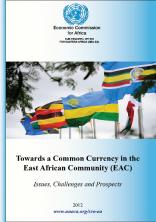Towards a Common Currency in the East African Community(EAC)

Interest in regional integration, including monetary integration, in Africa has been intense over the decades since independence and various regional groupings have been formed. Those initiatives were stimulated by the general small size of individual economies leading to a desire of promoting economies of scales in production and distribution. Currently, two monetary integrations in Africa are in place: the CFA franc zones (UEMOA and CEMAC) and the Common Monetary Area (CMA) in South Africa. However, several regional monetary union projects are planned such as ECOWAS, COMESA, SADC and EAC and a common currency for Africa is a long-term goal of the African Union.
The major benefits of a monetary union are the reduction in transaction costs, economies of international reserves, the elimination of exchange rate risk and region-wide price harmonization. On the other hand, the costs of a monetaryunion are related to the loss of sovereignty over monetary and exchange rate policy, especially in the case of asymmetry shocks that make the same monetary policy inappropriate for all member countries of a monetary union. Indeed, in a monetary union, member countries loose unilateral control over instruments (monetary policy instruments and exchange rate policy) that may be crucial in dealing with country specific macroeconomic shocks.
In general, for countries to benefit from a monetary union, they should meet the following criteria which contribute to mitigate the effects of asymetric shocks: flexibility of prices and wages; high interregional factor mobility and a high degree of openness allowing a country or region to absorb shocks without the need of adjusting the nominal exchange rate; a high degree of product diversification helping to overcome industry specific shocks; a high degree of fiscal integration to absorb the impact of asymmetric shocks through fiscal transfers from one to another country; a convergence of inflation rates to avoid causingvariations of the terms of trade; and the political will ( Bagnai, 2010).
In addition, a new currency will be attractive if it is more stable in terms of better mainitaining its purchasing powerthan the currencies it replaces. This may come from a stong institutional framework within the monetary union, achieving more discipline over fiscal policies insulating the regional central bank from pressures to provide monetary financing.